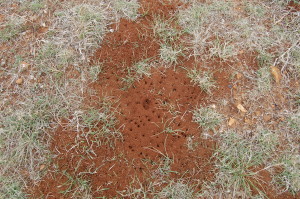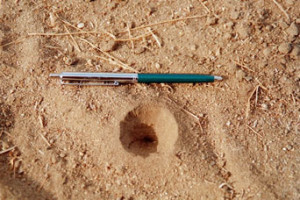
Inactive red ant bed found in April 2013 on the parade ground at historic Fort Richardson near Jacksboro, Texas. The weather was very cold for that time of the year and the mound was not buzzing with activity even though the grass was turning green.
Throughout much of recorded history in North Texas red ants and doodle bugs were inconspicuous residents of plains and fields. They minded their own business, crafted unique habitats, and defended themselves against enemies. Sounds like a good life for our six-legged neighbors, right?
They were snug and happy until human children discovered their abodes. What child hasn’t spent time watching ants march in a straight line bringing food back to feed the queen in the bowels of the mound. If one laid a twig or bit of hay in the path, the ants never climbed over, they simply marched around and kept on going. Never mind that red ants stung with a vengeance. It was absolutely necessary to keep an eye on the ground so not to step on one of the little creatures, especially if one were barefooted.
The mortal enemy of the red ant was the horned toad, or as TCU fans call them, horned frogs. The red ant was to the horned toad what a fine beef filet is to a human. Since red ants hibernate in the winter, I suppose that horned toads do also.
For hundreds of years this food chain worked fabulously, until the advent of DDT and fire ants.
Cotton and wheat farmers detested red ants because their mounds often covered more than seven square feet of ground; the ants destroying all vegetation around and within the mound. As the ant colony grew, new mounds or beds were often started in a fairly close proximity. That took precious real estate from the farmer. Also, those working cotton from planting to picking were sometimes barefoot, creating an occupational hazard. Wheat farmers fared better, they wore boots and seldom walked over the ground. Yet all those mounds lessened the total amount of wheat harvested.
Following World War II and the introduction of DDT, farmers and ranchers waged war on the little red guys. It was an accepted belief that if a calf, especially a newborn calf, laid down on a red ant bed, the ants would sting it to death if the baby didn’t get up and escape quickly. Ranchers also claimed that if red ants got into the bags of range cubes, the cows wouldn’t eat them. Quoting Jeff Moorman, DVM, “obviously the cattle were smart enough to realized that it was more nutritious to eat dry grass than molasses rich cubes with stinging ants.” Cowmen also claimed that if cattle grazing too near an ant bed were stung, it could result in a slight drop in production or efficiency.
So cattle men and farmers spent the two decades following WWII with a paperboard shaker of DDT in their pickups. When they saw an ant bed, they came to a halt, opened the door, and sprinkle a healthy dose of poisonous DDT on the bed before driving off. It would take a ban on DDT by the federal government before this habit was ceased.
As for fire ants, it may be a myth, but they took the blame for the demise of the red ant and subsequently the horned toad. Truth be known, DDT probably accounted for the slaughter of both.

A doodlebug hole with tempting dead grass stalks nearby. What a great way for a child to while away time on a hot summer day. Aggravation for the doodlebug but no real harm like DDT.
Doodlebugs created far less havoc than red ants. In fact, doodlebugs trapped and devoured red ants, but not to the extent of horned toads. Doodlebug is a common name for ant lions, residents of any arid, sandy habitat throughout the world. If a red ant strayed from the line, he often slipped into the trap, cum abode, seen below. While the doodlebug was smaller than a red ant, it took the trapper little time to consume the trapped.
For children though, the fun was to drop a grain or two of sand into the doodlebug hole, then watch it frantically rearrange the intruding grains into the walls of the trap. Doodlebugs were semi-communal insects so when one hole was found there were others nearby. With several holes, a child could while away half of the morning watching the little guys rebuild their homes. When asked what she had done, the child could truthfully answer, “nothing.” Believe me, I know.
